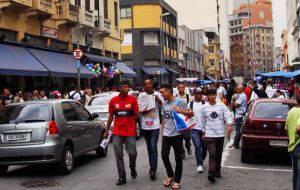MercoPress. South Atlantic News Agency
Latam rapidly turning into middle class continent, says World Bank
 Middle class is defined as anyone making 10 to 50 US dollars per day
Middle class is defined as anyone making 10 to 50 US dollars per day A World Bank report released Tuesday found that Latin America and the Caribbean registered a 50% jump in the number of people joining the middle class during the last decade, which was called by economists an historic achievement for a region long exposed to wealth inequality.
The report, called “Economic Mobility and the Rise of the Latin American Middle Class’’, found that the middle class in the region grew to an estimated 152 million in 2009, compared to 103 million in 2003, an increase of 50%.
“The recent experience of Latin America and the Caribbean shows the world that policies balancing economic growth while still expanding opportunities for the most vulnerable can spread prosperity to millions of people,” said WB President Jim Yong Kim. “Governments in Latin America and the Caribbean still need to do much more – one third of the population is still in poverty – but we should celebrate this achievement of growing the middle class and learn from it.”
For decades, poverty reduction and middle class growth in the Latin America and Caribbean region (LAC) crept along at a very slow pace, as low growth and stubborn inequality held back progress. Over the last ten years, however, the region’s fortunes improved dramatically due to changes in government policies that emphasized the delivery of social programs alongside economic stability.
The end result: The middle class grew by a half to include 30% of the region’s population in 2009. Among the highest achievers were Brazil, which comprised about 40% of the region’s middle class growth; Colombia, where 54% of people improved their economic status between 1992 and 2008; and Mexico, which had 17% of its population join the middle class between 2000 and 2010.
Today, the middle class and the poor in Latin America account for roughly the same share of the population, according to the report.
The report found that some of the key factors favouring the upward mobility in Latin America were higher levels of education among workers; higher employment in the formal sector; more people living in urban areas; more women in the labour force; and smaller families. The report defined middle class in income terms of anyone making between 10 and 50 dollars per day. This level of income provides an increased resilience to unexpected events and reflects a lower probability of falling back into poverty.
The report, however, also described a fourth, vulnerable class, which underscored the need for countries to do much more to increase shared prosperity. Members of this vulnerable class, representing 38% of the population, fared better income-wise than the poor, but lacked the economic security of the middle class. Sandwiched between the two, the vulnerable class makes between 4 and 10 dollars per capita, per day.
The report also determined that, with the exception of years of schooling, intergeneration mobility remains limited. A young person’s parents’ economic and social background still plays a substantial a role in determining that person’s economic future.
This may change, however, according to Augusto de la Torre, Chief Economist for Latin America and the Caribbean at the World Bank. “A society with a growing middle class is more likely to reduce such inequalities,” he said. “It is widely recognized that the middle class is an agent of stability and prosperity. For a middle-income region such as Latin America’s, a larger middle class has crucial* implications.”
Around the world, a larger middle class can mean better governance, deeper credit markets, and greater spending in social sectors, such as public health and education. But this promise has not yet been fully realized for Latin America, explained the authors of the report. They cited historical reasons for that.
In the second half of the 20th century, the region’s small upper and middle classes had limited commitments to and expectations from their government; they were not asked to pay much in taxes and did not expect to receive much from public services. As a result the state was typically small and the middle class tended to opt out of public services, paying privately even for core services such as electricity and security.
While this picture has been changing in the past 10 to 20 years, the region’s fragmented social contract often keeps the middle class opting out, and unwilling to contribute to the public purse. This in turn reduces the opportunities for those who remain poor to join the recent entrants into the middle class.
The report identifies three strategies which governments could employ to gain the support of the middle class for a fairer and more legitimate social contract:
Explicitly incorporate the goal of equal opportunities into public policy to break the perception that the system is rigged in favor of the most privileged.
Embark on a second generation of reforms to the social protection system -- including both social assistance and social insurance -- to overcome fragmentation and thus enhance fairness and efficiency.
Break the vicious cycle of low taxation and low quality of public services by investing some of the region’s commodity windfall to improve the quality of public services, service and administration
This social policy debate on how to achieve greater buy-in from the wealthier segments of society is likely to remain a key topic in Latin America for the foreseeable future. To drive such discussion, the report concluded that the right set of reforms will results in the middle class becoming an increasingly powerful agent of change to expand prosperity to those left behind.





Top Comments
Disclaimer & comment rules-

-

-

Read all commentsIt is becoming increasingly clear that Latin American economic policies contrary to the Washington Consensus, Neoliberalism and the International Monetary Fund have enabled Latin America (Kirchner, Lula-Rousset, Correa, Chavez, Morales, Ortega etc.) Have brought political sovereignty, economic independence and social justice in Latin America.
Nov 14th, 2012 - 02:09 pm 0The slogan is: For you to do well economically, disobeying the IMF and the World Bank.
The example is the crisis in Europe with the deepening of the economic crisis to further neoliberal IMF.
face1354@hotmail.com
1 Raul
Nov 14th, 2012 - 03:17 pm 0Ha, ha, ha.
Argentina is doing OK? Ha, ha, ha.
Correa, Dead Man Walking Cahez, Morales: ha, ha, ha to the power Googol.
Brasil are already finding out it's a little more difficult than they thought and THEY are the only ones worth talking about. The rest are robbing their own people, one way or another.
Raul,
Nov 14th, 2012 - 03:19 pm 0Look at the numbers. Middle-class is being defined as USD 10 – 50 per day. The legal minimum wage in Chile is approx USD 12 / day. This makes all of Chile, except the 6% unemployed middle-class. ...I am sure they will all be delighted with their new status.
Commenting for this story is now closed.
If you have a Facebook account, become a fan and comment on our Facebook Page!